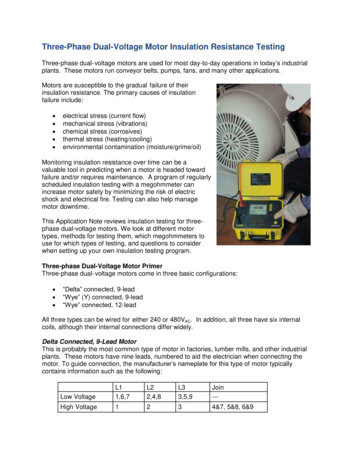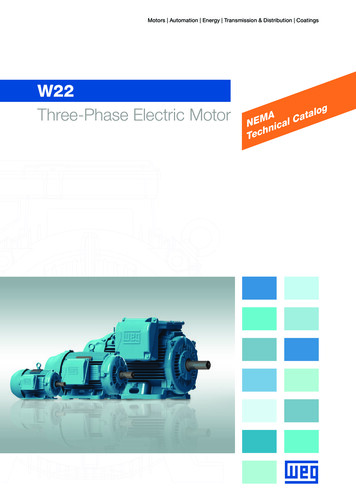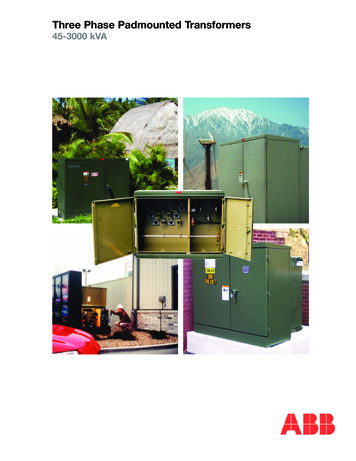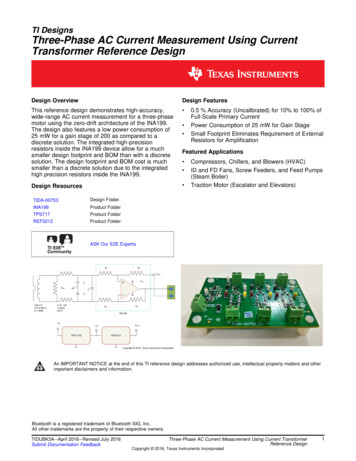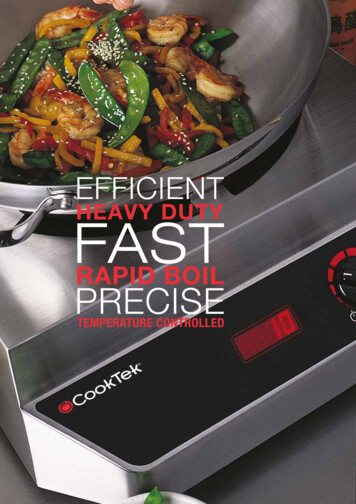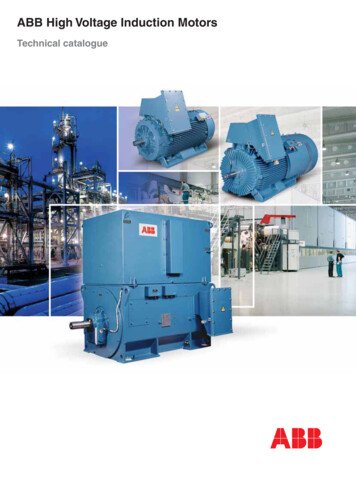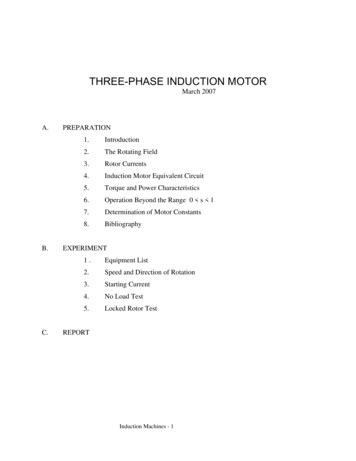
Transcription
THREE-PHASE INDUCTION MOTORMarch 2007A.B.C.PREPARATION1.Introduction2.The Rotating Field3.Rotor Currents4.Induction Motor Equivalent Circuit5.Torque and Power Characteristics6.Operation Beyond the Range 0 s 17.Determination of Motor Constants8.BibliographyEXPERIMENT1.Equipment List2.Speed and Direction of Rotation3.Starting Current4.No Load Test5.Locked Rotor TestREPORTInduction Machines - 1
Induction Machines - 2
Induction Machines - 3
Induction Machines - 4
Induction Machines - 5
Induction Machines - 6
Induction Machines - 7
Induction Machines - 8
Induction Machines - 9
Induction Machines - 10
Induction Machines - 11
Induction Machines - 12
Induction Machines - 13
Induction Machines - 14
Rather than the equivalent circuit of Fig. 10, we choose one more akin to Fig. 9to yield the result shown in Fig. 13. Based on past experience, the followingsimplifying assumptions can be made for this model:Induction Machines - 15
X0 X1 , R0 jX0 R2 jX2 , and X1 X2 . NOTE WELL: This is based upon a WYEmodel and therefore represents but one of the three phases.For the rotor locked, s 1 so that the following equations can be written from the equivalent circuit ofFigure 13 assuming R0 jX0 R2 jX2 :Z11 (R1 R2) j(X1 X2), Z11 V1/I1 , andPPH (R1 R2)I12These equations can be solved for R2, X1 , and X2 as follows:R2 (PPH/I12) R1and (by assumption)X1 X2 ½ Z11 2 (R1 R2)2 .Assuming that the stator resistance R1 is measured at DC and that phase powerPPH , phase voltage V1 , and phase current I1 are measured, R2, X1, and X2 can be calculated for themotor from the locked rotor test data.From the data obtained from the no-load test, we can determine the values for the series circuitelements R0 and X0. To find these values, we draw graphs of power and line current versus appliedvoltage as shown in Figure 14.First the measured I1 and the measured phase power PPH are used to calculatePC PFW PPH I12R1 ,2where I1 R1 is the copper loss in this no-load case, PC [W] is the per-phase core loss and PFW [W] isthe per-phase friction-and-windage. The derived values are then appropriately plotted and a suitableapproximating curve put through them; this curve is then cleverly extrapolated backwards to thevoltage origin, and because core loss varies as V1α, its intercept gives the friction-and-windagepower loss . This will be explored further on the next page. The observant student will note the italicized and bold-face material in this sentence and realize that brainpower may be moreimportant than computer power in getting this right.Induction Machines - 16
Figure 14For no load, s 0 so that the following equations can be written from the equivalent circuit of Figure13:ZIN (R1 R0) j(X1 X0) ZIN V1/I1.PPH PCu PC PFW I12(R1 R0) PFW .Thus:R0 [PPH PFW]/I12 - R1X0 ZIN 2 (R1 R0)2 X1.Assuming that phase power PPH, phase voltage V1, and phase current I1 are measured and thatfriction-and-windage loss PFW has been obtained as shown in Figure 14, R0 and X0 can also becalculated for the motor from the no-load test data.8. Bibliography(1) A.S. Langsdorf, Theory of Alternating Current Machinery, 2nd. ed., New York, McGrawHill, 1955.(2) T.S. Reynolds and T. Bernstein, "The Damnable Alternating Current", Proceedings ofIEEE, (64) pgs. 1339-1343, Sept. 1976.(3) P.L. Alger and R.E. Arnold, "The History of Induction Motors in America", Proceedings ofIEEE, (64), pgs. 1380-1383, Sept. 1976.Induction Machines - 17
B.EXPERIMENT1. Equipment ListOne Instrumentation Rack with the usual test equipmentOne 208 Volt, 0.75 HP, 3-phase induction motorOne dynamometer with torque controllerOne Phase Sequence IndicatorOne single-phase wattmeter plus miscellaneous apparatus as needed2. Initial DataRecord all nameplate information for the induction motor. You should alsomake a DC measurement of stator winding line-to-line resistance using a DMM.3. Speed and Direction of RotationThe motor is mounted in a test rig that allows one to control the torqueapplied to the motor shaft and to measure both rpm and torque. The rpm sensoroperates on a Hall effect principle and consists of a disk bearing on its peripherytwo magnetic pole-pairs and a detector that pulses once each time a pole-pair isrotated past it. Observe that, by counting the output of the detector, you will geta frequency, φ [Hz] , that is twice the actual rotational frequency of the motor.Thereforemotor rpm n 60 (½φ) 30φ .To observe the rpm sensor in operation, proceed as follows. Energize thedetector with 20 VDC ; and attach its output to the oscilloscope, the torquecontroller, and frequency counter. Power up the motor normally and determinethe no-load * rpm when the motor, as viewed from the front, is rotating clockwise(CW); repeat with the motor spinning counter clockwise (CCW).BE CAREFUL !!It can hurt to tangle with a three-phase motor.A successful salesman for General Electric's motor division onceremarked to one of your instructors that, when asked by a customer how a motor*The “no-load” condition is that which obtains when the controller knob is fully counter-clockwise.Induction Machines - 18
actually worked, he invariably replied "Very well, indeed.". This attitude is typicalof a technologically mature discipline: one really can afford to treat the device asif it were a black box. Therefore, in addition to determining the short circuit andopen circuit characteristics of your motor you will also have to determine its inputand output powers. To this end, it will be assumed that the motor is a balancedthree phase wye connected load and that you will therefore need to measureonly one line-neutral voltage, only one line current, and only one phase power tocharacterize Pin completely. That is,Pin 3Pline-neutral 3Pphase 3IrmsVrmscosθ.Take note that Vrms is the phase voltage Vline-neutral Vline-line/3.Further,2πnPout 2πfT 60 T πφT,where T is the shaft torque, measured with the dynamometer in-oz, which mustbe converted to N.m in order to obtain power in watts.4. Starting CurrentWire up the motor for CW motion so that starting current can be measuredaccurately using the oscilloscope # . With no load on the motor and 120 Vrms, lineline,turn on the power and observe and record the transient starting current & .5. No Load Test.Precisely 1 h after the scheduled start of the lab, you must be prepared tomeasure Vrms and φ(Vrms), Irms(Vrms), Pphase(Vrms). Because there is no way tocontrol Vrms at the bench, all lab groups are required to take their measurementsin synchrony as the line-line voltage is varied at the control panel by theinstructor. Line-to-line voltage will be varied from 30 to 210 V in steps of 30 V.6. Locked Rotor Test.This portion of the experiment will begin immediately after the NO LoadTest is complete. With the motor de-energized, lock the rotor with the woodenclamp-on fixture provided. Turn on the power. Note that Vrms will initially be low,#Remember that you are working with polyphase power . Therefore it will be essential for you to distinguishcarefully between line-line and line-neutral voltages.&Just how this is done is up to you. But it can be done. It just can’t be done swiftly unless you design yourmeasurement in advance.Induction Machines - 19
and the instructor will then raise it in steps until Irms(Vrms) Ifull-load. Measure Vrmsand φ(Vrms), Irms(Vrms), Pphase(Vrms). Turn off the power.7. Torque vs. Speed Curves.Immediately after the Locked Rotor Test is complete, the instructor willreset the line-to-line voltage to approximately 120 Vrms. The dynamometer is adevice that allows placing a variable load on the motor. Use the weightsprovided, and vary the control current to the dynamometer so that the motor willbe loaded with a torque roughly proportional to the control current. This controlcurrent is feedback regulated by the output from the rpm sensor, but only if yourun the necessary coax: should you omit this coax, your data will be subtlydegraded. Since the product of motor torque (T) and shaft angular velocity (πφ)is power, the dynamometer is absorbing energy. This energy is dissipatedprimarily as heat, and the dynamometer temperature will therefore rise. It isadvisable to feel the dynamometer case occasionally to insure that it is notoverheating. Note that the torque exerted upon the motor by the dynamometer isindicated by the appropriate scale on the dynamometer circumference. In usingthe dynamometer, care should be taken (i) to avoid sudden substantial variationsof control current and (ii) to avoid sudden motor starts with the control current on.These can slam the dynamometer against its limit stops. Treat the dynamometeras the sensitive instrument that it is.Complete the experiment as follows. First, begin at no load and, bygradually increasing the dynamometer control current, measure φ, Pphase(φ), T(φ),and I(φ) as φ gradually decreases. Continue this until you reach rated current.The motor should not stall # . However, if it does stall, quickly reduce thedynamometer current to restart the motor.#Win laurels! Improve your grade! The instructors have a nagging suspicion that these induction motors have apull-up torque. But, in the entire history of the course, no one has ever been able to detect one. Solve thismystery and garner esteem.Induction Machines - 20
C.REPORT(a)Based on your data from the no-load and locked-rotor tests, do thefollowing. Plot graphs similar to those described in Figure 14 and find the powerlost due to friction and windage. Compute the following: (1) the stator windingphase resistance R1 from your line-to-line measurement, (2) numerical values ofthe exciting path elements Ro and Xo at rated voltage, and (3) numerical valuesof R2 and X1 and X2 at rated current. Assume that X1 is equal to X2. Show yourfinal equivalent circuit (Figure 13) for the induction motor using these values,(b)Use your equivalent circuit to calculate the expected startingcurrent of the motor assuming 120 Vrms, line-line and no load. Is your calculatedvalue close to the observed value? Comment. [Note: You will have to study Fig.13 and Section 7 with care to answer this question successfully.](c)Use your equivalent circuit to generate smooth theoretical curves ofslip (%), torque (ft-lbs), power in (watts), power out (Hp), efficiency (%), linecurrent (Amp), and power factor versus motor speed (rpm). All of theseparameters are to be computed at 120 Vrms, line-line and six separate graphs are tobe made using the same motor speed scale. Next, overlay the experimentalpoints onto these graphs and comment cogently.(d)Using your equivalent circuit, compute the motor horsepower atrated line-to-line voltage of 208V and rated speed. Compare your result with the0.75 Hp given as the rated output on the motor nameplate. Is 0.75 Hp aconservative value for this motor?Induction Machines - 21
To find these values, we draw graphs of power and line current versus applied voltage as shown in Figure 14. First the measured I 1 and the measured phase power P PH are used to calculate . P C P FW P PH I 1 2 R 1, where I. 1 2. R. 1. is the copper loss in this no-load case, P. C [W
